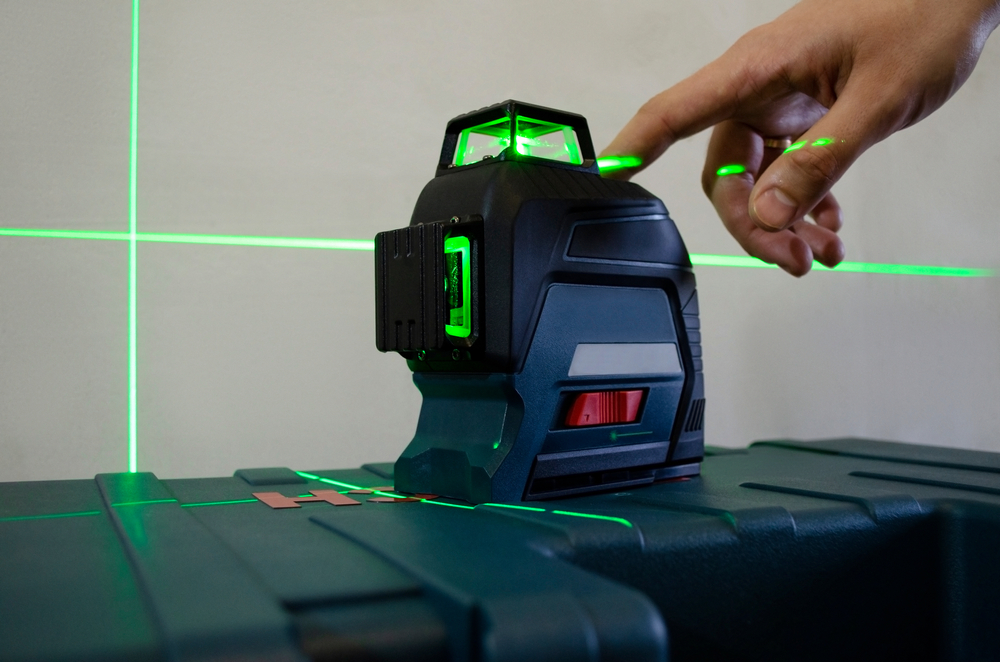What Is a Laser Level?

A laser level is a device used by surveyors and architects to take digital measurements that aid the construction process. They look similar to a camera or electronic box, and they emit a laser light forward, sometimes in a straight line or with a cross-shaped pattern. These construction levels emit a laser beam that is used to measure a plot of land by determining the height, depth, and range of the terrain. Laser levels are often placed on a tripod for increased stability and for additional height to allow them to project farther. The information gathered by using the level is essential for modern-day construction, and laser levels can more accurately and quickly measure both large plots of land and small areas than previous tools and manual methods.
What Is a Laser Level Used For?
Out of the various tools in construction, the laser level is one of the most important. Used in most large projects, this tall camera-like device can be seen overlooking construction sites for a variety of industries. Levels have been used for centuries, but recent advancements in technology have taken accuracy to the next level with the pinpoint precision of laser levels. These advancements have brought new capabilities to the worksite, allowing contractors to establish both horizontal and vertical planes, square reference points, and define plum lines. The advanced construction tools are used in site layouts, in land surveys, for checking grades and elevations, and in the creation of drainage plans.
While laser levels can perform a wide range of tasks, it is important to remember that some lasers are application-specific. If you want the best results with the most accuracy, then consider using a laser that is designed for your specific needs. Some laser levels have the ability to rotate to map out interior spaces, provide stronger beams for longer distance measuring, or have several settings for horizontal or vertical alignment.
Different Types of Laser Levels
Let’s take a look at the various different models and types of laser levels used in construction. The three main types of laser levels are dot lasers, line levels, and rotary levels. They are each named and categorized based on the endpoints of their lines and the space they can measure.
Dot Lasers
These are lasers that can project multiple beams of light, and they are often used to lay out wall lines or when putting up partitions. They are an excellent choice for projects where a point or reference is needed from one surface to another, such as the floor to the ceiling or a wall. The Spectra LP51G is an exceptional dot laser level that can produce a five-point green beam that is visible even in outdoor lighting, and it can provide accuracy down to ¼ of an inch at 50 feet.
Line Levels
A line level does just what its name suggests — it measures using a line of light. These laser lines can project 180 degrees either vertically or horizontally, or sometimes two lines can be used to project both. These levels are ideal for a project where a vertical line is needed. The Spectra Precision LT52G is a green-line laser that can produce five point lasers and cross lines for both vertical and horizontal measurements. It has automatic leveling and offers accuracy within ⅛ of an inch at 5 feet. While this instrument has two cross line lasers, making it a line level, it also has five point lasers, allowing it to function as a dot level as well.
Rotary Levels
Rotary levels expand beyond what a line level can measure, with full 360-degree rotations. Despite only using a single beam of light, these construction tools can measure both vertical and horizontal plane measurements and are also self-leveling. The Topcon RL-H5A Rotary Laser is accurate within 1/16 of an inch at 100 feet, and it has a total range of 2,600 ft. It has a slope feature that makes it excellent for excavations and the capability to automatically re-level itself. Its alkaline battery provides over 100 hours of continuous use, and it boasts a tough IP6 waterproof rating.
While we have just looked at examples of the three different types of laser levels, it is important to note that there are several great brands, such as Topcon, Spectra Precision, Leica, and DeWalt, that produce outstanding and accurate levels of all kinds. Lasers can also be categorized according to the strength of their beam and how safe they are to use. Class 1 and 2 are the most common, with some less commonly used allowances for the more powerful Class 3R levels. The class of laser relates to the safety of operating or observing the laser beam. No matter which type of laser you are using on the construction site, be sure to never look directly into the beam, and use protective eyewear if you are going to be around lasers for long periods.
Laser levels can also be classified by the different features they have that make your construction project easier:
- Green/red beam lasers
- Automatic/self-leveling laser
- Horizontal/vertical beam
- Rotating lasers
Indoor/outdoor levels
How To Pick the Right Laser Level
Superior Instruments offers a wide variety of laser levels from leading brands such as Spectra Precision, Topcon, Lecia, and DeWalt. While any of these options provide precision accuracy and the battery and durability to perform on a busy jobsite without issue, each contractor or team has its own preference. These lasers also have different specialties and capabilities, making some levels better for certain tasks. Shop around and check out reviews for the best laser levels in the industry to find out which is right for you.
Still not sure which level to choose? Check out our blog on How To Choose the Best Laser Level for more information. Or call us today at (888) 852-7377 to speak with an expert.
|